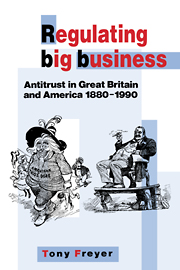Book contents
- Frontmatter
- Contents
- Preface
- Introduction
- 1 The response to big business: the formative era, 1880–1914
- 2 The divergence of economic thought
- 3 The political response
- 4 The courts respond to big business
- 5 The impact of World War I, 1914–1921
- 6 Tentative convergence, 1921–1948
- 7 A British antimonopoly policy emerges, 1940–1948
- 8 Uneven convergence since World War II
- Conclusion
- Notes
- Index
1 - The response to big business: the formative era, 1880–1914
Published online by Cambridge University Press: 21 January 2010
- Frontmatter
- Contents
- Preface
- Introduction
- 1 The response to big business: the formative era, 1880–1914
- 2 The divergence of economic thought
- 3 The political response
- 4 The courts respond to big business
- 5 The impact of World War I, 1914–1921
- 6 Tentative convergence, 1921–1948
- 7 A British antimonopoly policy emerges, 1940–1948
- 8 Uneven convergence since World War II
- Conclusion
- Notes
- Index
Summary
The stability of a ruling social class existing within a compact market created in Britain the basis for business self-regulation. In America, however, a federal system superimposed upon wider social tensions and a larger market diverted conflict into the formal channels of official policymaking. The British courts and Parliament sanctioned loose combinations and restrictive practices which, despite the great merger wave, sustained the comparatively greater control of family firms and modest-scale enterprise. The illegality of these same legal forms in America weakened the influence of small business and encouraged the triumph of managerially centralized, giant corporations in the same merger movement. On the whole, then, the factors facilitating the British consensus toward nonintervention ensured that the law merely followed the interests of the established business group. The broad-based conflicts driving the American demand for government action, however, fostered the displacement of the old business order by a new one, capable of much greater domination. Yet the British failure to develop vertically integrated corporate structures reinforced the belief that underdeveloped managerial centralization contributed to the nation's relative economic decline.
THE SOCIAL MILIEU AND THE MARKET
In America, but not in Britain, the rise of large corporations threatened the already existing business order. Well into the twentieth century British family firms retained more control throughout the economy. The market and legal pressures facilitating business combinations did not undercut the family enterprise because it could continue to function as a single autonomous subsidiary within a loose organizational structure. Furthermore, financial transactions among family firms influenced the development of the stock market, which in turn encouraged the merger movement.
- Type
- Chapter
- Information
- Regulating Big BusinessAntitrust in Great Britain and America, 1880–1990, pp. 11 - 42Publisher: Cambridge University PressPrint publication year: 1992



